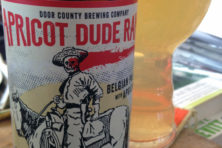The Lettie Mink Ranch
- Share
- Tweet
- Pin
- Share
Northern Door is well known for its orchards and fishing boats and fallow dairy farms. And while most visitors are familiar with Mink River, few of them know that the peninsula once was home to mink ranches. At the corner of Waters End and Double Z two long empty mink sheds remain partially hidden in the tall grass and weeds on the old Lettie farm. Once as many as nine sheds held caged mink destined to become fur coats.
Floyd Lettie began his venture into mink farming around 1942, his 90-year-old sister Carolyn Lettie Johnson recalls. She and her husband Oscar were silent partners with Lettie and his wife Helen for the first few years of the enterprise.
But that was not Johnson’s first experience with a mink ranch. The three Manson brothers, who were her uncles, already were raising mink on North Bay Road.
Her daughter Karen Johnson-Zak remembers that as children she and her brothers helped out with feeding and watering at the Lettie mink ranch. “One of the hardest parts,” she said, “was dragging the hose to water them,” when she helped her cousin Joanne Lettie with chores.
While the critters may have cuddly fur, “No one ever had a pet mink!” Karen said. Because the little animals were vicious, handlers had to wear heavy leather gloves. And just as those who know the ways of lobsters feel little sympathy when those crustaceans meet their makers, mink raisers do not become soft-hearted tending their charges.
“When we were kids,” Karen said, “we’d poke fingers in a mink cage to see who’d keep one in there the longest.” The game was dangerous, as given the opportunity a mink would bite off a finger.
Standard procedure for safely opening the side cage door to feed a mink, she said, was to blow a puff of air through the hardware cloth into the creature’s face. When it backed away to the far side of the cage, the door could be quickly opened and closed. Her brother Corwin, who worked for his Uncle Floyd for many years, one time inadvertently reversed the procedure, opening the door and then puffing at the mink. The result: “The mink bit him on the lip!” Karen said.
Carolyn’s brother-in-law Karl Johnson also assisted on the Lettie mink ranch. “I worked for them for about three years during the mid-1950s,” he said, “when I first started farming.” He soon realized that he was not cut out for the mink business, as he lacked the ability to distinguish subtle differences in the colors of pelts, an important skill. The furs were graded according to color, as some shades were more valuable, and mink subsequently were bred, capitalizing on recessive genes, to achieve desirable hues. Sometimes wild mink were bred with domestic for color development.
A male mink is approximately the size of a cat, only with a slender body; a female is about half that size.
The Johnsons explained that mink were raised in enclosures much like rabbit hutches. The mink sheds were long low affairs with double rows of cages separated by a center aisle. Fluted watering cups were wired on the cages.
March was the breeding season for mink. After a short gestation period, each female gave birth to a litter of four or five kits during early summer. By December the kits were mature and then pelted. Karl Johnson estimated that the population of 250 females would produce as many as 1,200 mink for the annual harvest.
Karl remembers that sonic booms produced when jets broke the sound barrier caused problems for mink growers when kits were young. Nervous female mink mothers sometimes became disturbed by loud noises and as a result, killed their young.
Some details of the mink business are not for the squeamish. During the later years of mink farming, the animals were fed a dry food, much like the kibble now given to dogs and cats. But through the early years the food was fresh, and stored in a freezer in the building the workers called “the cooler.”
The “recipe” for mink food might include horsemeat from superannuated animals purchased for slaughter, “bloaters” (fish that had spent too much time in the nets) and parts from butchered animals not used for human consumption. The meat was placed in grinders along with vegetables to create mink food.
After the years of home-made but before the advent of dried, mink raisers purchased frozen blocks of prepared food.
The process of pelting the mink in December was not for the fainthearted either. During the first years of the operation, the critters’ necks were broken (much as chickens’ necks were once wrung) for the slaughter. Carolyn remembers that her brother’s shoulders ached from the work.
“They have tough necks!” she said of the mink.
Karl helped with the killing when he worked on the ranch. “A person was pretty strong in the arms in those days,” he said.
But with his second year of work, lethal injections of a solution of Black Leaf 40 (a product for controlling poultry lice) were used. The deadly agent was nicotine. “We thought maybe we should quit smoking,” Karl joked.
The creatures were skinned, keeping the heads, feet and tails attached. Along with coats and jackets, stoles created from a series of the mink (the mouth of each clipped to the tail of the next) were popular.
“I almost threw up that first year,” Karl said, “because of the smell of the musk gland by the tail.” But in time he became accustomed to the odor.
A good skinner could pelt an animal in only a minute. And a fringe benefit, he recalled, was that the skinner’s “hands became nice and soft from the mink fat.” But his forearms above the protective leather gloves would bear scars from mink bites.
The carcasses were hauled away by a company that used them to make soap and mink oil for waterproofing shoes.
On the second floor of “the cooler” building, the pelts were cleaned and stretched. Carolyn helped scraping fat from pelts during the harvest. “I kept my work clothes hung in the basement,” she said, remembering the unpleasant odor of the process.
The cleanly scraped pelts were stretched, tacked and dried on pelting frames, thin pieces of wood about 40 inches long, two inches wide at the top and gradually increasing in width to six inches.
And then, the minks were ready for shipping to the companies that produced fur garments. Narrow strips were stitched together to make the coats and jackets.
But by the mid-1970s furs were losing their appeal and the Lettie’s went out of business. George Logerquist, Art Linden, George Jischke, Eldred Koepsel, and Glenn Weborg once had mink enterprises in Northern Door, too. Now their businesses and the men as well are gone.
A number of factors contributed to the demise of mink ranching. “At first there was a living in it,” Carolyn said, “but then you needed a second job.” Cheaper fur imports from Russia affected the industry.
Fashion tastes changed, too. While diamonds remained a girl’s best friend, mink coats no longer were. PETA members in plastic shoes carrying buckets of paint shaped attitudes toward fur coats as well.
But those whose only experience with mink coats is limited to ratty old furs in antique shops and second-hand stores cannot imagine the luxury of mink garments in their prime.
“It was a durable fur,” Karl said, “long wearing, good guard fur and fine under fur.”
“Mink furs had to be kept in cold storage during the summer,” Carolyn said. “Care was very important.”
The history of Door County is not just about apples and cherries, fishing and tourists, but is a rich and varied heritage. Mink ranches once were located throughout the peninsula. Now we can choose to wrinkle our noses at the unpleasant aspects of the industry or imagine burying our noses in the luxury of the finished furs, but when we drive by the corner of Waters End and Double Z, we can still catch glimpses of our past.






